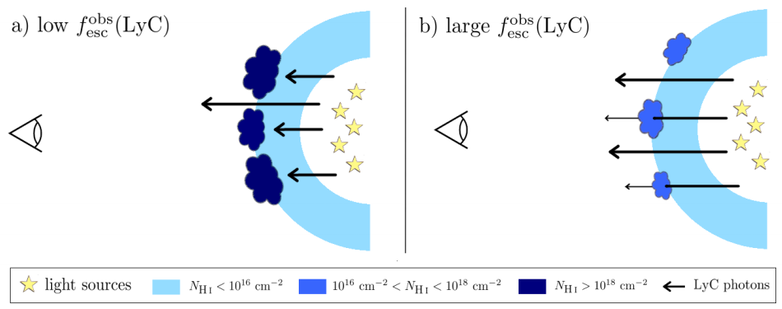Neutral gas properties of galaxies emitting ionizing photons
Gazagnes, S., Chisholm, J., Schaerer, D., Verhamme, A., Rigby, J. R., and Bayliss, M. Neutral gas properties of Lyman continuum emitting galaxies: Column densities and covering fractions from UV absorption lines. Astronomy & Astrophysics, 2018.
Chisholm, J., Gazagnes, S., Schaerer, D., Verhamme, A., Rigby, J. R., Bayliss, M., Sharon, K.,Gladders, M. and Dahle, H. Accurately predicting the escape fraction of ionizing photons using rest-frame ultraviolet absorption lines. Astronomy & Astrophysics, 2018.
Context
To understand how the Universe was reionized, we must constrain how the ionizing photons propagated from the galaxies' environment to the inter-galactic
medium of the Univers. In 2017, I worked for 5 months at the Geneva Observatory in Switzerland, in collaboration with John Chisholm, Daniel Schaerer and Anne Verhamme, and analyzed 18 spectroscopic observations of local galaxies emitting ionizing photons to understand how ionizing photons escape their interstellar medium. We analyzed their neutral gas and dust properties, and key outcomes are detailed below.
To understand how the Universe was reionized, we must constrain how the ionizing photons propagated from the galaxies' environment to the inter-galactic
medium of the Univers. In 2017, I worked for 5 months at the Geneva Observatory in Switzerland, in collaboration with John Chisholm, Daniel Schaerer and Anne Verhamme, and analyzed 18 spectroscopic observations of local galaxies emitting ionizing photons to understand how ionizing photons escape their interstellar medium. We analyzed their neutral gas and dust properties, and key outcomes are detailed below.
Ionizing photons escape through channels in a patchy neutral environment.
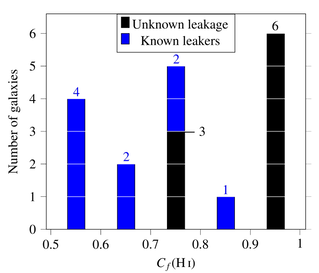
Histogram of the neutral gas covering fraction in sample of 18 galaxies. Leakers (in blue) have the lowest covering fractions
Through the anlysis of neutral hydrogen absorption lines, we measured the covering fraction of the neutral gas in the galaxy. This covering fraction, noted Cf(HI), is proportional to the fraction of the line-of-sight that is covered by dense gas where ionizing photons can't escape. In a first paper published in 2018 (paper 1 above), we showed that galaxies leaking ionizing photons had low covering fractions, suggesting such that a certain amount of ionizing photons can escape the interstellar medium because there exists holes or channels in the dense gas clouds (in other words, the gas around the stars is porous). This is shown by the histogram on the left (known leakers in blue have the lowest HI covering fractions).
Paper 1 also investigates how can we accuretely derive the neutral gas properties of a certain galaxy based on the characteristics of the observing instrument, and explores the connections between the covering fraction of the neutral hydrogen, and the covering fraction of other ions (e.g., singly ionized ions). More details on these topics can be found in the paper (link to paper 1 above).
Paper 1 also investigates how can we accuretely derive the neutral gas properties of a certain galaxy based on the characteristics of the observing instrument, and explores the connections between the covering fraction of the neutral hydrogen, and the covering fraction of other ions (e.g., singly ionized ions). More details on these topics can be found in the paper (link to paper 1 above).
Predicting the escape fraction of ionizing photons.
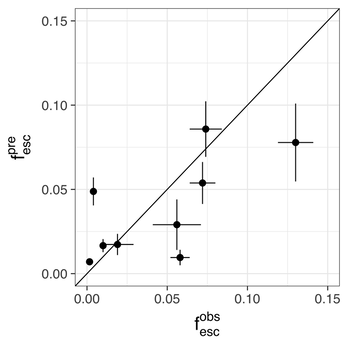
The predicted escape fraction (determined using the HI covering fraction and dust attenuation) versus the observed escape fraction (determined using direct observations of the ionizing flux) of ionizing photons. For 7 out of 9 galaxies, the predicted values reproduce accurately (within the error bars) the observed values.
In a companion paper, we investigated how one can predict the escape fraction of ionizing photons (the fraction of ionizing photons produced that actually escapes from the galactic environment) using the neutral gas covering fraction. We highlight that an equation combining the covering fraction of the neutral hydrogen gas and the dust extinction (i.e. photons "absorbed" by dust grains) in the galaxy accurately reproduces the observed escape fraction of the galaxy (right figure, with the y axis shows the value given by the equation and the x-axis gives the observed value). This outcome is particularly important for observations close to the Epoch of Reionization: indeed, the observed escape fraction is not directly measurable at these high redshifts, hence, indirect estimations (such as the one ennbled by the proposed equation) are crucial to constrain the amount of ionizing photons actually escaping galaxies during reionization.
This second paper also explores the use of other quantities, such as the Lyman alpha escape fraction, or the O III / O II ratio to estimate the escape fraction of ionizing photons.
This second paper also explores the use of other quantities, such as the Lyman alpha escape fraction, or the O III / O II ratio to estimate the escape fraction of ionizing photons.
In short:
- Constraining how the ionizing photons escape from galaxies is crucial to understand how star-forming galaxies might have reionized the Universe
- Local galaxies emitting ionizing photons have a low neutral gas covering fraction, suggesting that the ionizing photons escape through holes or low density channels spanning in a patchy thick neutral environment.
- The escape fraction of the ionizing photons in these galaxies can be predicted using the measured covering fraction of the neutral hydrogen and dust attenuation. This indirect method is promising to find leaking candidates at high-redshift.
The origin of the escape of Lyman alpha and ionizing photons
Gazagnes, S., Chisholm, J., Schaerer, D., Verhamme, A., & Izotov, Y. The origin of the escape of Lyman α and ionizing photons in Lyman continuum emitters. Astronomy & Astrophysics, 2020.
Context
As a follow-up of the previous work detailed above, I published in May 2020 a paper that further explores the escape of ionizing photons in a sample of 22 galaxies, including 13 galaxies with a confirmed leakage of ionizing photons (so called leakers). This new paper investigates the Lyman alpha properties of these galaxies and extend the analysis of the leakage of ionizing photons using three additional leakers that have very large escape fractions observed: 36, 42 and 73 %.
As a follow-up of the previous work detailed above, I published in May 2020 a paper that further explores the escape of ionizing photons in a sample of 22 galaxies, including 13 galaxies with a confirmed leakage of ionizing photons (so called leakers). This new paper investigates the Lyman alpha properties of these galaxies and extend the analysis of the leakage of ionizing photons using three additional leakers that have very large escape fractions observed: 36, 42 and 73 %.
The Lyman alpha properties of low-redshift star-forming galaxies
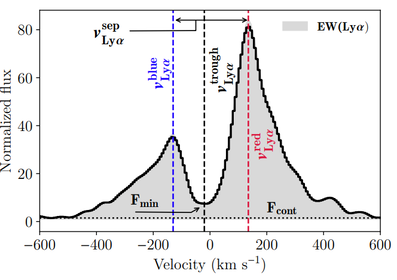
The Lyman alpha profile observed in one galaxy of the sample analyzed. The
Lyman alpha properties are labelled on the figure.
Lyman alpha is a peculiar transition of the neutral hydrogen atom, which leads to the emission or absorption of a photon at a wavelength of 1216 angstrom. Lyman alpha photons are heavily impacted by the neutral hydrogen kinematics and spatial distribution. These photons are constantly being absorbed and remitted by neutral hydrogen atoms, and each of these interactions changes the photon's frequency. The left figure presents an example of a Lyman alpha profile we observe in local star-forming galaxies. A bunch of very important neutral gas properties can be extracted from these profiles. For example, studies suggest that the velocity difference between the blue and red peak (shown with blue and red dashed lines) provides insights about the amount of neutral gas in the interstellar medium.
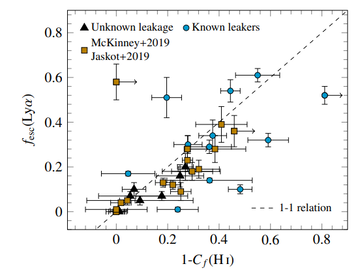
The escape fraction of the Lyman alpha photons versus the amount of low column density channels in the galaxy.
The escape mechanisms of Lyman alpha and ionizing photons are closely connected, which is particularly useful to understand the properties that favor their escape. In the sample analyzed, we found that the porosity of the interstellar medium (presence of channels with no or little neutral gas) is a crucial ingredient to understand the emergent Lyman-alpha profile. The right picture highlights the tight relation that exists between the escape fraction of the Lyman alpha photons and the amount of "escape channels" (shown as 1-Cf(HI)). This is a very exciting result as, combined to the results shown above, it supports that Lyman alpha photons and ionizing photons escape through the same regions in the galaxy.
Similarly, the paper also highlights tight correlations between the HI covering fraction and several Lyman alpha properties, such as as the peak velocities, the equivalent width (integrated observed emission) and the flux at the minimum profile. For the interested reader, the link to the paper is shows above.
A simplified picture of the escape of the ionizing photons
Thanks to this unique sample, we found additional evidence that, in the largest leakers, the amount of low density channels might not be enough to explain the large escape fractions of ionizing photons. It is likely that these galaxies have overall lower quantity of neutral gas in the whole interstellar medium. This is the difference highlighted by the picture below.
Thanks to this unique sample, we found additional evidence that, in the largest leakers, the amount of low density channels might not be enough to explain the large escape fractions of ionizing photons. It is likely that these galaxies have overall lower quantity of neutral gas in the whole interstellar medium. This is the difference highlighted by the picture below.
This figure highlights that, if a galaxy has a low escape fraction of ionizing photons, these photons likely escape through low-density paths spanning through dense clouds covering the bulk of stars. For galaxies having large escape fractions, the latter is likely the combination of the fraction of ionizing photons that escape through low-density channels, and of the fraction of ionizing photons that pass through denser regions, though these denser regions are not opaque enough to absorb all incident radiation.
This paper also further discusses the importance of the equation using the covering fraction of the neutral Hydrogen or Silicium II to indirectly estimate the escape fraction of ionizing photons at high-redshift
In short:
- The ISM porosity (amount of low density channels) is one origin the escape of ionizing and Lyman-alpha photons in local leakers. Dust also plays a key role in regulating the amount of these photons that escape.
- The most extreme leakers (galaxies with largest escape fraction of ionizing photons) likely have a lower quantity of neutral hydrogen in their interstellar medium.
- The combination of the covering fraction of the neutral gas and the dust attenuation is promising to indirectly estimate the escape fraction of ionizing photons for galaxies at high-redshift.
